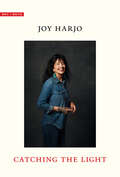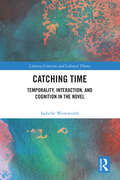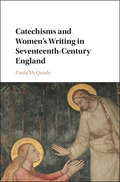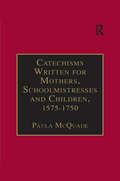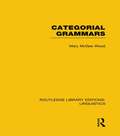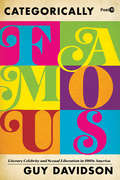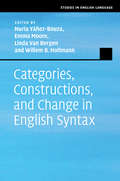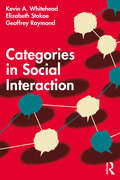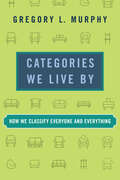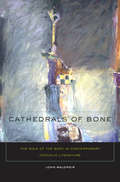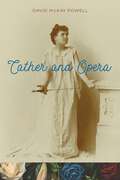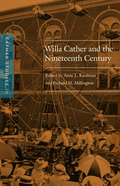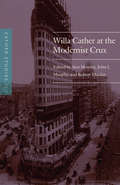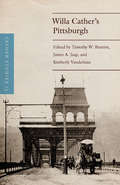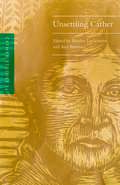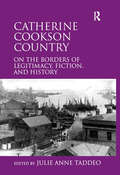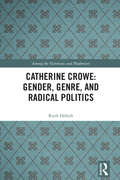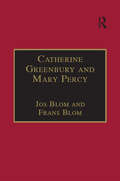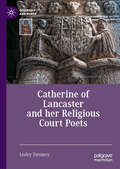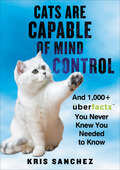- Table View
- List View
Catching the Light (Why I Write)
by Joy HarjoUnited States Poet Laureate and winner of the 2022 Academy of American Poets Leadership Award Joy Harjo examines the power of words and how poetry summons us toward justice and healing &“Her enduring message—that writing can be redemptive—resonates: &‘To write is to make a mark in the world, to assert &“I am.&”&’ The result is a rousing testament to the power of storytelling.&”—Publishers Weekly &“Harjo writes as if the creative journey has been the destination all along.&”—Kirkus Reviews In this lyrical meditation about the why of writing poetry, Joy Harjo reflects on significant points of illumination, experience, and questioning from her fifty years as a poet. Composed of intimate vignettes that take us through the author&’s life journey as a youth in the late 1960s, a single mother, and a champion of Native nations, this book offers a fresh understanding of how poetry functions as an expression of purpose, spirit, community, and memory—in both the private, individual journey and as a vehicle for prophetic, public witness. Harjo insists that the most meaningful poetry is birthed through cracks in history from what is broken and unseen. At the crossroads of this brokenness, she calls us to watch and listen for the songs of justice for all those America has denied. This is an homage to the power of words to defy erasure—to inscribe the story, again and again, of who we have been, who we are, and who we can be.
Catching Time: Temporality, Interaction, and Cognition (Literary Criticism and Cultural Theory)
by Isabelle Wentworth'Time travels in divers paces with divers people.' Shakespeare’s oft-quoted line contains a hidden ambiguity: not only do individual people experience time differently, but time travels in diverse paces when we are with diverse persons. The line articulates a contemporary understanding of subjective time: it is changed by interaction with our social environment. Interacting with other people—and even literary characters—can slow or quicken the experience of time. Interactive time, and the paradigm of enactive cognition in which it sits, calls for an expansion of traditional ideas of time in narrative. The first book-length study of interactive time in narrative, Catching Time explains how lived time and narrative time interpenetrate each other, so that the relational model of subjective time acts as a narrative function. Catching Time develops a novel, interdisciplinary framework, drawing on cognitive science, narratology, and linguistics, to understand the patterns of temporality that shape narrative.
Catechisms and Women’s Writing in Seventeenth-Century England
by Paula McquadeCatechisms and Women's Writing in Seventeenth-Century England is a study of early modern women's literary use of catechizing. Paula McQuade examines original works composed by women - both in manuscript and print, as well as women's copying and redacting of catechisms - and construction of these materials from other sources. By studying female catechists, McQuade shows how early modern women used the power and authority granted to them as mothers to teach religious doctrine, to demonstrate their linguistic skills, to engage sympathetically with Catholic devotional texts, and to comment on matters of contemporary religious and political import - activities that many scholars have considered the sole prerogative of clergymen. This book addresses the question of women's literary production in early modern England, demonstrating that reading and writing of catechisms were crucial sites of women's literary engagements during this time.
Catechisms Written for Mothers, Schoolmistresses and Children, 1575-1750: Essential Works for the Study of Early Modern Women: Series III, Part Three, Volume 2 (The Early Modern Englishwoman: A Facsimile Library of Essential Works Series III, Part Three)
by Paula McQuadeAs works designed for mothers to instruct their children within the home, early modern mother-directed catechisms, like traditional catechisms, use the question-and-answer format to present the basic tenets of the Protestant faith. But such catechisms differ from traditional ones in how they represent the mother-child relationship. Because catechisms discuss fine questions of theology, and because they present a non-contentious image of maternal authority, many literary critics and cultural historians have failed to explore their cultural significance, focusing instead upon secular, dramatic representations of motherhood in early modern plays and pamphlet accounts of murderous mothers. This collection demonstrates that these catechisms provide valuable insight into constructions of early modern maternity, and more broadly, into the degree of power and authority accorded to women in the early modern Protestant family. It includes nearly all of the extant catechisms the editor was able to locate which were designed expressly for mothers and published between 1550 and 1750.
Categorial Features
by Phoevos PanagiotidisProposing a novel theory of parts of speech, this book discusses categorization from a methodological and theoretical point a view. It draws on discoveries and insights from a number of approaches - typology, cognitive grammar, notional approaches, and generative grammar - and presents a generative, feature-based theory. Building on up-to-date research and the latest findings and ideas in categorization and word-building, Panagiotidis combines the primacy of categorical features with a syntactic categorization approach, addressing the fundamental, but often overlooked, questions in grammatical theory. Designed for graduate students and researchers studying grammar and syntax, this book is richly illustrated with examples from a variety of languages and explains elements and phenomena central to the nature of human language.
Categorial Grammars: Linguistics: Categorial Grammars (Routledge Library Editions: Linguistics)
by Mary McGee WoodIn the last few years categorial grammars have been the focus of dramatically expanded interest and activity, both theoretical and computational. This book, the first introduction to categorical grammars, is written as an objective critical assessment. Categorial grammars offer a radical alternative to the phrase-structure paradigm, with deep roots in the philosophy of language, logic and algebra. Mary McGee Wood outlines their historical evolution and discusses their formal basis, starting with a quasi-canonical core and considering a number of possible extensions. She also explores their treatment of a number of linguistic phenomena, including passives, raising, discontinuous dependencies and non-constituent coordination, as well as such general issues as word order, logic, psychological plausibility and parsing. This introduction to categorial grammars will be of interest to final year undergraduate and postgraduate students and researchers in current theories of grammar, including comparative, descriptive, and computational linguistics.
Categorial Morphology: Linguistics: Categorial Morphology (Routledge Library Editions: Linguistics)
by Jack HoeksemaThis book presents an account of certain problems of morphological analysis that occurs within a theoretical framework that derives its inspiration from recent studies of the lexicon in generative grammar. The starting point is the controversy about the proper analysis of synthetic compounds. Are they really compounds, or phrasal derivations, or do they constitute a type of word formation of their own?
Categorically Famous: Literary Celebrity and Sexual Liberation in 1960s America (Post*45)
by Guy DavidsonThe first sustained study of the relations between literary celebrity and queer sexuality, Categorically Famous looks at the careers of three celebrity writers–James Baldwin, Susan Sontag, and Gore Vidal–in relation to the gay and lesbian liberation movement of the 1960s. While none of these writers "came out" in our current sense, all contributed, through their public images and their writing, to a greater openness toward homosexuality that was an important precondition of liberation. Their fame was crucial, for instance, to the growing conception of homosexuals as an oppressed minority rather than as individuals with a psychological problem. Challenging scholarly orthodoxies, Guy Davidson urges us to rethink the usual opposition to liberation and to gay and lesbian visibility within queer studies as well as standard definitions of celebrity. The conventional ban on openly discussing the homosexuality of public figures meant that media reporting at the time did not focus on his protagonists' private lives. At the same time, the careers of these "semi-visible" gay celebrities should be understood as a crucial halfway point between the era of the open secret and the present-day post-liberation era in which queer people, celebrities very much included, are enjoined to come out.
Categories, Constructions, and Change in English Syntax (Studies in English Language)
by Yáñez-Bouza Nuria Emma Moore Van Bergen Linda Willem B. HollmannA pioneering collection of new research that explores categories, constructions, and change in the syntax of the English language. The volume, with contributions by world-renowned scholars as well as some emerging scholars in the field, covers a wide variety of approaches to grammatical categories and categorial change, constructions and constructional change, and comparative and typological research. Each of the fourteen chapters, based on the analysis of authentic data, highlights the wealth and breadth of the study of English syntax (including morphosyntax), both theoretically and empirically, from Old English through to the present day. The result is a body of research which will add substantially to the current study of the syntax of the English language, by stimulating further research in the field.
Categories in Social Interaction
by Kevin A. Whitehead Elizabeth Stokoe Geoffrey RaymondThis book investigates the situated (re)production of categories, from the most mundane and unremarkable to those most strongly associated with power and privilege. By examining the reciprocal relationships between categorial phenomena and the basic structures and practices of social interaction, the book provides a new framework for integrating conversation analysis and membership categorization analysis.Across its ten chapters, the book describes a conversation analytic approach to studying categories and categorization, charts the development and history of membership categorization analysis, and addresses core methodological challenges and practices associated with using this approach. After mapping out the new framework developed in the book, each chapter describes intersections between categorial phenomena and the domains that comprise the infrastructure of social interaction. The book concludes by exploring applications, interventions, and impacts of understanding categories in ways examined across the preceding chapters, and by considering future avenues for excavating categorial practices in the ordinary, institutional, and technological settings of human social life.Categories in Social Interaction is essential reading for social scientists with an interest in categories of people and categorizing practices, and especially for practitioners and students of conversation analysis, membership categorization, ethnomethodology, and discursive psychology.
Categories We Live By: How We Classify Everyone and Everything
by Gregory L. MurphyAn in-depth analysis of how humanity&’s compulsion to categorize affects every aspect of our lived experience.The minute we are born—sometimes even before—we are categorized. From there, classifications dog our every step: to school, work, the doctor&’s office, and even the grave. Despite the vast diversity and individuality in every life, we seek patterns, organization, and control. In Categories We Live By, Gregory L. Murphy considers the categories we create to manage life&’s sprawling diversity. Analyzing everything from bureaucracy&’s innumerable categorizations to the minutiae of language, this book reveals how these categories are imposed on us and how that imposition affects our everyday lives.Categories We Live By explores categorization in two parts. In part one, Murphy introduces the groundwork of categories—how they are created by experts, imperfectly captured by language, and employed by rules. Part two provides a number of case studies. Ranging from trivial categories such as parking regulations and peanut butter to critical issues such as race and mortality, Murphy demonstrates how this need to classify pervades everything. Finally, this comprehensive analysis demonstrates ways that we can cope with categorical disagreements and make categories more useful to our society.
Category Neutrality: A Type-Logical Investigation (Outstanding Dissertations in Linguistics)
by Neil Whitman"Feature neutrality" is an issue that has received much attention among linguists. For example, consider the sentence, "I have never, and will never, put my name on this document." Here, the verb 'put' acts simultaneously as a past participle (as in "have never put") and a base form (as in "will never put"), and is therefore said to be neutral between the two forms. Similar examples have been found for many languages. The accepted wisdom is that neutrality is possible only for morphosyntactic features such as verb form, gender, number, declension class-not at the level of gross syntactic category, where the semantic differences are more significant. In other words, it has been claimed that "category neutrality," where a word or phrase is used simultaneously with more than one syntactic category, does not exist. (A famous example is the glaring ungrammaticality of this sentence, in which "can" is used simultaneously as a main verb and auxiliary verb: "I can tuna and get a new job.") In this book, however, Neal Whitman shows that category neutrality does exist in English. This not only challenges the current thinking, but also raises foundational questions about the nature of ambiguity.
Cathedrals of Bone: The Role of the Body in Contemporary Catholic Literature
by John C. WaldmeirThe metaphor of the Church as a "body" has shaped Catholic thinking since the Second Vatican Council. Its influence on theological inquiries into Catholic nature and practice is well-known; less obvious is the way it has shaped a generation of Catholic imaginative writers. Cathedrals of Bone is the first full-length study of a cohort of Catholic authors whose art takes seriously the themes of the Council: from novelists such as Mary Gordon, Ron Hansen, Louise Erdrich, and J. F. Powers, to poets such as Annie Dillard, Mary Karr, Lucia Perillo, and Anne Carson, to the Pulitzer Prize-winning playwright John Patrick Shanley. Motivated by the inspirational yet thoroughly incarnational rhetoric of Vatican II, each of these writers encourages readers to think about the human body as a site-perhaps the most important site-of interaction between God and human beings. Although they represent the body in different ways, these late-twentieth-century Catholic artists share a sense of its inherent value. Moreover, they use ideas and terminology from the rich tradition of Catholic sacramentality, especially as it was articulated in the documents of Vatican II, to describe that value. In this way they challenge the Church to take its own tradition seriously and to reconsider its relationship to a relatively recent apologetics that has emphasized a narrow view of human reason and a rigid sense of orthodoxy.
Cather and Opera
by David McKay PowellThroughout her fiction, Willa Cather mentioned forty-seven operas. References to opera appear in all but three of her twelve novels and in roughly half of her short stories. Despite a dearth of musical education, Cather produced astute writing about the genre beginning in her earliest criticism and continuing throughout her career. She counted opera stars among her close friends, and according to Edith Lewis, her companion throughout adulthood, the two women frequently visited the theater, even in the early days, when purchasing tickets to attend performances proved a financial sacrifice. Melding cultural history with thoughtful readings of her works and discussions of opera’s complex place in turn-of-the-century America, David McKay Powell’s Cather and Opera offers the first book-length study of what drew the writer so powerfully and repeatedly to the art form. With close attention to Cather’s fiction and criticism, Powell posits that at the heart of both her work and the operatic corpus dwells an innate tension between high artistic ideals and popular acceptance, often figured as a clash between compositional integrity and raw, personal emotion. Considering her connection to opera in both historical and intertextual terms, Cather and Opera investigates what operatic references mean in Cather’s writing, along with what the opera represented to her throughout her life.
Cather Studies, Volume 10: Willa Cather and the Nineteenth Century (Cather Studies)
by Cather Studies Richard H. Millington Anne L KaufmanWilla Cather and the Nineteenth Century explores, with textual specificity and historical alertness, the question of how the cultures of the nineteenth century—the cultures that shaped Willa Cather’s childhood, animated her education, supplied her artistic models, generated her inordinate ambitions, and gave embodiment to many of her deeply held values—are addressed in her fiction. In two related sets of essays, seven contributors track within Cather’s life or writing the particular cultural formations, emotions, and conflicts of value she absorbed from the atmosphere of her distinct historical moment; their ten colleagues offer a compelling set of case studies that articulate the manifold ways that Cather learned from, built upon, or resisted models provided by particular nineteenth-century writers, works, or artistic genres. Taken together with its Cather Studies predecessor, Willa Cather and Modern Cultures, this volume reveals Cather as explorer and interpreter, sufferer and master of the transition from a Victorian to a Modernist America.
Cather Studies, Volume 11: Willa Cather at the Modernist Crux (Cather Studies)
by Cather Studies Ann Moseley John J. Murphy Robert ThackerWilla Cather at the Modernist Crux examines Willa Cather’s position in time, in aesthetics, and in the world. Born a Victorian in 1873, Cather made herself a modernist through the poems, stories, and novels she wrote and published into the twentieth century. Beginning with a prologue locating Cather’s position, this volume of Cather Studies offers three sets of related essays. The first section takes up Cather’s beginnings with her late nineteenth-century cultural influences. The second section explores a range of discernible direct connections with contemporary artists (Howard Pyle, Frederic Remington, and Ernest Blumenschein) and others who figured in the making of her texts. The third section focuses on The Song of the Lark, a novel that confirms Cather’s shift westward and elaborates her emergent modernism. An epilogue by the editors of The Selected Letters of Willa Cather addresses how the recent availability of these letters has transformed Cather studies. Altogether, these essays detail Cather’s shaping of the world of the early twentieth century and later into a singular modernism born of both inherited and newer cultural traditions.
Cather Studies, Volume 12: Willa Cather and the Arts (Cather Studies)
by Cather StudiesOver the five decades of her writing career Willa Cather responded to, and entered into dialogue with, shifts in the terrain of American life. These cultural encounters informed her work as much as the historical past in which much of her writing is based. Cather was a multifaceted cultural critic, immersing herself in the arts, broadly defined: theater and opera, art, narrative, craft production. Willa Cather and the Arts shows that Cather repeatedly engaged with multiple forms of art, and that even when writing about the past she was often addressing contemporary questions. The essays in this volume are informed by new modes of contextualization, including the increasingly popular view of Cather as a pivotal or transitional figure working between and across very different cultural periods and by the recent publication of Cather&’s correspondence. The collection begins by exploring the ways Cather encountered and represented high and low cultures, including Cather&’s use of &“racialized vernacular&” in Sapphira and the Slave Girl. The next set of essays demonstrates how historical research, often focusing on local features in Cather&’s fiction, contributes to our understanding of American culture, from musicological sources to the cultural development of Pittsburgh. The final trio of essays highlights current Cather scholarship, including a food studies approach to O Pioneers! and an examination of Cather&’s use of ancient philosophy in The Professor&’s House. Together the essays reassess Cather&’s lifelong encounter with, and interpretation and reimagining of, the arts.
Cather Studies, Volume 13: Willa Cather's Pittsburgh (Cather Studies)
by Cather StudiesWilla Cather wrote about the places she knew, including Nebraska, New Mexico, New York, and Virginia. Often forgotten among these essential locations has been Pittsburgh. During the ten years Pittsburgh was her home (1896–1906), Cather worked as an editor, journalist, teacher, and freelance writer. She mixed with all sorts of people and formed friendships both ephemeral and lasting. She published extensively—and not just profiles and reviews but also a collection of poetry, April Twilights, and more than thirty short stories, including several collected in The Troll Garden that are now considered masterpieces: &“A Death in the Desert,&” &“The Sculptor&’s Funeral,&” &“A Wagner Matinee,&” and &“Paul&’s Case.&” During extended working vacations through 1916, she finished four novels in Pittsburgh.Cather Studies, Volume 13 explores the myriad ways that these crucial years in Pittsburgh shaped Cather&’s writing career and the artistic, professional, and personal connections she made there. With contributions from fourteen well-known Cather scholars, this collection of essays recognizes the importance Pittsburgh played in Cather&’s life and work and deepens our appreciation of how her art examines and elucidates the human experience.
Cather Studies, Volume 14: Unsettling Cather (Cather Studies)
by Cather StudiesAmerican author Willa Cather was born and spent her first nine years in the Shenandoah Valley of Virginia. Here, as an observant daughter of a privileged white family, Cather first encountered differences and dislocations that remained lively, productive, and sometimes deeply troubling sites of tension and energy throughout her writing life. The essays in Cather Studies, Volume 14 seek to unsettle prevailing assumptions about Cather&’s work as she moved from Virginia to Nebraska to Pittsburgh to New York City to New Mexico and farther west, and to Grand Manan Island. The essays range from examinations of how race shapes and misshapes Cather&’s final novel, Sapphira and the Slave Girl, to challenges to criticisms of her 1935 novel, Lucy Gayheart. Contributors also frame fresh discussions of Cather&’s literary influences and cultural engagements in the first decade of her career as a novelist through the lens of sex and gender and examine Cather&’s engagements with region as a geopolitical, sociolinguistic, and literary site. Together, the essays offer compelling ways of seeing and situating Cather&’s texts—both unsettling and advancing Cather scholarship.
Catherine Cookson Country: On the Borders of Legitimacy, Fiction, and History
by Julie Anne TaddeoBritain's most widely read author of the late twentieth century, Catherine Cookson published more than 100 books, including The Fifteen Streets, The Black Velvet Gown, and Katie Mulhollond. Set in England's industrial northeast, her novels depict the social, economic, and emotional hardships of that area. In the first essay collection devoted to Cookson, the contributors examine what Cookson's memoirs and historical fiction mean to readers, including how her fans contribute to her position in the cultural imaginary; constructions of gender, class, and English and Irish identity in her work; the importance of place in her novels; Cookson's place in the heritage industry; and television adaptations of Cookson's works. Cookson's work tackled topics that were still taboo in the early post-World War II era, such as domestic abuse, rape, and incest. This collection places Cookson in historical context and shows how skillful she was at pushing generic boundaries.
Catherine Crowe: Gender, Genre, and Radical Politics (Among the Victorians and Modernists)
by Ruth HeholtThis is the first full-length study of the popular Victorian writer Catherine Crowe (1790-1872). Crowe is increasingly being recognised as an important and influential figure in the literary and Spiritualist circles of the nineteenth century. This monograph offers a reassessment of her major works, arguing that her writing is prescient. Best known today for her collection of "real" ghost tales The Night Side of Nature: or of Ghosts and Ghost Seers, Crowe also wrote five popular novels as well as numerous short stories and essays. Innovative and sometimes original in their use of genre, her works cover the Newgate genre, help to initiate detective fiction, include elements of the social problem novels of the 1840s, and point the way to the sensation novels of the 1860s. Politically radical in many ways Crowe was vocal about women’s oppression by men, social inequality, poverty, slavery, and animal rights. This volume aims to restore an author who was "[o]nce as famous as Dickens or Thackeray" (Wilson 1986, v) to her proper place in the scholarly discussion of Victorian literature.
Catherine Greenbury and Mary Percy: Printed Writings 1500–1640: Series 1, Part Four, Volume 2 (The Early Modern Englishwoman: A Facsimile Library of Essential Works & Printed Writings, 1500-1640: Series I, Part Four #Vol. 2)
by Jos BlomThis volume includes two early seventeenth-century translations of Roman Catholic books by English recusant nuns - Catherine Greenbury (a Franciscan) and Mary Percy (a Benedictine). To practise their faith on the continent both these women fled Elizabethan England where Roman Catholic practice had been outlawed under pain of severe penalty (even death). Catherine Greenbury was born at York into a wealthy upper middle-class family but left England after the death of her husband, shortly after the birth of her daughter in or around 1616. After establishing herself in Brussels in a convent dedicated to St Elizabeth, she became its first elected 'Mother' in 1626. During her early years here she translated the work included in this volume - François van den Broecke's biography in Dutch of the saintly Queen Elizabeth of Portugal. A comparison of Greenbury's version with the Dutch text shows not only that the translation is very competent and faithful, but also that she takes the editorial freedom to improve the text. Lady Mary Percy, daughter of Thomas Percy the seventh Earl of Northumberland, left England for Flanders and in 1598 she founded a Benedictine convent in Brussels especially for Englishwomen. Here Mary Percy translated a 1598 French edition of Breve compendio, by the Italian Jesuit Achille Gagliardi with his student Isabella Berinzaga, a mystical handbook which guides the reader through a series of elaborately defined stages striving towards 'deiformitie' - a state in which the soul is 'united unto the will of God'.
Catherine of Lancaster and her Religious Court Poets (Queenship and Power)
by Lesley TwomeyThis book offers an integrated study of the English princess and Castilian queen Catherine of Lancaster (1373–1418), drawing on available archival, architectural, and poetic sources in England and Spain. Catherine’s mother, Queen of Castile in exile, and father, the powerful military commander John of Gaunt, raised her to take the Castilian throne. This volume connects Catherine’s early life, providing insights into those who promoted her cause from birth as Princess of Castile, and her later life as Princess of Asturias, then Queen-consort, and finally Dowager and Co-regent of Castile. Her influence on the Castilian court’s poetic circles has not previously been connected to her English heritage. Poetry written about her and influenced by her was compiled into a songbook presented to her son, Juan II. The book brings new understanding of the role an Englishwoman played in Trastámara Castile’s turbulent history.
The Catholic Imaginary and the Cults of Elizabeth, 1558–1582
by Stephen HamrickStephen Hamrick demonstrates how poets writing in the first part of Elizabeth I's reign proved instrumental in transferring Catholic worldviews and paradigms to the cults and early anti-cults of Elizabeth. Stephen Hamrick provides a detailed analysis of poets who used Petrarchan poetry to transform many forms of Catholic piety, ranging from confession and transubstantiation to sacred scriptures and liturgical singing, into a multivocal discourse used to fashion, refashion, and contest strategic political, religious, and courtly identities for the Queen and for other Court patrons. These poets, writers previously overlooked in many studies of Tudor culture, include Barnabe Googe, George Gascoigne, and Thomas Watson. Stephen Hamrick here shows that the nature of the religious reformations in Tudor England provided the necessary contexts required for Petrarchanism to achieve its cultural centrality and artistic complexity. This study makes a strong contribution to our understanding of the complex interaction among Catholicism, Petrachanism, and the second English Reformation.
Cats Are Capable of Mind Control: And 1,000+ UberFacts You Never Knew You Needed to Know
by Kris SanchezFrom the creator of the popular Twitter sensation UberFacts comes this fun compilation quiz book, packed with entertaining infographics and surprising factoids, for fans of Schott’s Miscellany, What If? and Ripley’s Believe It or Not.Providing "the most unimportant things you’ll never need to know”—fun and surprising facts, statistics, and infographics on diverse subjects, from art and science to history and popular culture—UberFacts has become one of the most widely followed and successful accounts on Twitter, followed by nearly 12 million people.Based on the popular social media phenomenon and culled from an exhaustive variety of sources—science journals, books, media, and literary magazines—Cats are Capable of Mind Control is a fascinating collection of shocking, delightful, educational, and informative facts and figures that are entertaining, topical, and sometimes downright bizarre (the safest place to suffer sudden cardiac arrest in the U.S. is a casino).Did you know:The Pentagon was constructed so that no point in the building is more than a ten-minute walk from any other point?Vultures’ stomach acid is so corrosive they can digest anthrax?Farmers in India use Coca-Cola and Pepsi as cheap and effective pesticides?Discover all this and much, much more in this treasure trove of trivia for the social media age.
